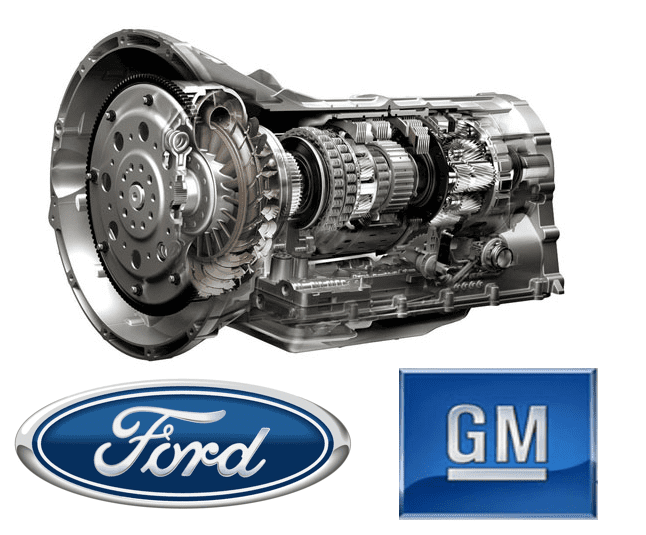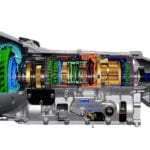The desire to increase efficiency out of drivetrains is hardly limited to the design and re-engineering of engine builds, with many transmissions being modified to include additional gearing. And the introduction of the long-awaited Ford/GM 10-Speed Transmission might just be the best depiction of that intent.
First announced back in 2013, the partnership between Ford and GM wasn’t the first of it’s kind, with a similar partnership between the two giants yielding the six-speed planetary-gear program which yielded millions of high-quality transaxles. It also changed the game by setting a new precedent when it comes to collaborative partnerships. And it’s worth pointing out that development of the 10-speed gearbox isn’t exclusive to the Ford/GM partnership with Toyota and Honda introducing their own variants. But regardless of which version has your attention, the 10-speed transmission is likely to find a permanent home outside of just the light-duty vehicles it was initially designed for. With medium and heavy-duty applications left unaccounted for, it’s not unreasonable to expect a prompt evolution. But we’re getting ahead of ourselves.
Ford and GM’s most recent partnership was first announced back in 2013, intended to yield both nine and ten-speed automatic transmissions. GM took lead in the engineering of the (Hydramatic 10L90) nine-speed transaxle unit, which was intended for front -or- all-wheel drive models with transversely mounted engines. Ford took point on the (10R80) ten-speed gearbox, setting their sights on rear -or- four-wheel drive vehicles equipped with longitudinally mounted engines.
Conceived with economy in mind, the expectation was that both companies would explore certain economies, thanks to the maximization of parts commonality. That said, differences arose during the development stage. And while both Ford and GM models would benefit from the ten-speed transmission, the nine-speed would be reserved to GM models with Ford reporting that they “didn’t get quite the result (they) anticipated from the arrangement, signed five years ago this month. Ford has elected not to use GM’s nine-speed transmission out of the box, opting instead for a series of new 8-speed transmissions on vehicles such as the Ford Edge, Ford Transit Connect and Lincoln Nautilus.”
But the ten-speed made an immediate splash in late 2017, introduced as part of Ford’s F-150 Raptor (as well as an option for the standard F-150, when equipped with the 375-hp 3.5-liter EcoBoost V6). On the GM side of the proverbial aisle, the ten-speed made its debut in the Chevy Camaro ZL1, with both automakers planning to spread its influence even wider come 2018. So with all of that in mind, let’s get to know the transmission a little bit better, with 11 things you need to know about Ford and GM’s 10-Speed Transmission.
1. Ratio Spread
Despite its relatively wide spread between 1st and 10th gear, the overall span for the 10-speed transmission is hardly the widest out there. At 7.384, it was determined (through extensive simulations) that there was no real benefit to widening the span to 7.4 or greater. In addition, the decision to limit the span ensured that top gear was more easily sustainable during highway driving sessions.
2. Ratio Closeness and Size of Gear Steps
With a wide ratio spread engineered with practicality in mind, the 10-speed transmission offers a modest 20% drop in RPM while shifting. When compared to the 25% drop seen in ZF eight-speeds, this is impressive, as it maintains close-to-peak power during full-throttle acceleration. In addition, it ensures smoother shift transitions (and better all-over operation) in towing scenarios, a primary concern for those behind the wheel.
3. Closeness of 8th, 9th and 10th
Operating as overdrive gears, the last three gears serve to improve acceleration, fuel economy and towing performance. Respectively, the ratios for each are .854 (8th) .689 (9th) and .636 (10th). As mentioned above, 10th gear is designed with highway speeds in mind, but the closeness of ratios allows for smooth 10-9 downshift when required. In fact, smooth might be an understatement as Ford’s intention was to make it ‘nearly imperceptible’.
4. Ease of Shifting
Shifting of the 10-speed transmission is facilitated by six clutches, engaging and disengaging in (dual-clutch) pairings. To prevent any decrease in efficiency, shifts do not require unlocking of the torque converter. And in contrast to conventional two-piece designs, its clutches are regulated by integrated solenoid valves, offering a quicker response. The transmission also offers quicker fill times, with the reduction in hydraulic passage lengths. Overall, this allows for a smooth launch and climb through the gears, as well as downshifting (as needed) without any sense of jarring interruption.
5. Reduction in Spin Loss
Noting that the 10-speed replaces a 6-speed transmission in many cases, Ford has made great efforts to minimize its mechanical friction spin losses. The result of these friction-reduction measures is that each of the gears operates more efficiently than those of the transmission that it replaces. Further efficiencies are found in control of its operating temperature, thanks to an internal thermal bypass.
6. Change in Packaging Footprint
Despite the increase in gearing, the 10-speed transmission gains a modest one-inch in length and four-pounds in weight. With a complete absence of cast-iron components, it utilizes a composite of high-strength steels, aluminum and composite materials. The result is a reduction in size and/or weight for a number of key components including (but not limited to) the torque converter, which loses .4-inch in width and 2-pounds in weight.
7. Optimized Operation
The internal clutches of the 10-speed transmission are operated by two different hydraulic pumps. The first pump (no longer places on the main shaft) reflects a reduction in length, and its off-axis design is designed to offer variable displacement, adjusting the pump output as needed. The second pump stands in for a hydraulic accumulator while taking up less space overall and proving more reliable. Electrically driven, it allows idle-stop capability and, combined, the two pumps optimize efficiency through temperature and transmission fluid pressure.
8. Transmission Fluid
Mercon ULV, a transmission fluid specially designed for the 10-speed transmission, follows the trend of ever-thinning viscosity experienced by transmission fluids and engine oils across the board. Considering that the viscosity of most transmission fluids fall between 6-7.5 centistokes, Mercon ULV’s 4.5 centistoke rating is impressive. Reducing both friction and risk of hydraulic pump overload, the fluid (combined with a new generation of filter) plays a key role in regulating temperature and efficiency. It is also designed to last the life of the transmission.
9. Complexity of Launch
Addressing the launch of the 10-speed transmission in broad strokes, Mike Levine, a Ford communications spokesperson shared that, “New product launches are complex, especially with new engines or transmissions. Every one of them presents different challenges and opportunities. But once a successful limited launch has been achieved, innovation can confidently be applied to other models.”
While Ford aimed integration at the F-150 and, more directly, it’s game-changing Raptor variant, vehicles were only released after extensive testing. GM followed a similar train of thought in regard to its Camaro ZL1, the first model year of which was released without the 10-speed transmission, allowing for further testing. Both decisions reflect prudence and a welcome sense of quality control amidst the barrage of recalls we’ve seen in recent years.
That said, Ford’s beat GM to the punch, with the release of the F-150 predating GM’s release of the ZL1.
10. Speaking of Recalls
Yes, there was a small recall of (2017-18) F-150’s and (2018) Expeditions, equipped with the 10-speed transmissions, earlier this year. The modest recall consisted of 142 units in full, and was based around the improper installation of a roll pin, which could potentially cause a loss of the ‘Park’ function. That said, the recall went into effect earlier this year, with all owners notified and without further issue.
11. Where to Find the 10-speed Transmission
With its 2017-2018 heralding, Ford has equipped 3 domestic models with the 10R80 transmission. Beginning with the F-150, it then made its way into the Mustang and the Expedition (as well as the Everest, and upcoming Ranger reboot). It can also be found in the Lincoln Navigator.
To date, GM has placed the 10L90 in the Camaro ZL1, Chevy Tahoe, Yukon Denali and Cadillac Escalade.
The full scope of where either will be integrated in 2019 and beyond remains to be seen. That said, the 10-speed transmission laughs in the face of naysayers, empowering both Ford and GM to offer a “have your cake and eat it too” solution who like the performance and efficiency of a CVT, but prefer a more traditional feel.






